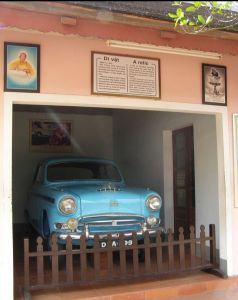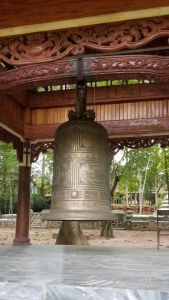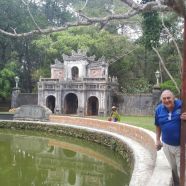The Way in Hue
The most spiritually evolved person I ever met was Thich Nhat Hanh, the Vietnamese Buddhist monk, peace activist, and author of over 100 books. In the 1990s, while I attended a week-long retreat at the Omega Institute, I walked with Thay (an affectionate title for teacher), mindfully, just the two of us, no words exchanged, and felt the deep peace of his soul energy dancing with me. He was completely and deeply present in the moment like a sun radiating beside me. With gentleness, his soul lifted me upward.
At the closing ritual for the retreat, the men and women were separated on the two sides of the room. This positioning intensified the energy like a hurricane, knocking me off balance except when I was between the two groups. I chose to sit in the middle back, balancing both male and female energy. Again, when Thay entered the room, I could feel his spirit raise the consciousness of the room by his profound presence. I have never forgotten how it felt to be with him.
A Methodist minister from a small town near me participated in the retreat and was in my sangha, a Buddhist discussion group. At the end of the retreat, he commented that, after all his years teaching Christianity from the pulpit, he never really understood Christianity until now when Thich Nhat Hahn helped him see his faith from a Buddhist perspective. Both Jesus and Buddha instruct humanity on how to transcend self to a divine awareness. They are not lifeguards to rescue us, but swim instructors to teach us. They both describe humility or nonattachment to self, dying daily to transcend self, and a higher perspective of Divine Love. We need a new wine skin, a new container for the higher frequencies of consciousness.
I always hoped I would see Thay again, but he was traveling widely internationally. Exiled from South Vietnam in 1966 after opposing the war, he lived in the United States and France. He received a scholarship to study comparative religions at Princeton and taught Buddhism at Columbia University. He established monasteries in the United States, Vietnam, Hong Kong, Australia, Thailand, and France. In 2014, he had a serious stroke, which left him unable to speak and unable to move his left side. After many years in exile, the Vietnamese government allowed him to visit and eventually stay in Hue, Vietnam at his original root temple for his final years. He had come full circle, returning to the Tu Hieu Monastery where he was a novice monk at age sixteen.

Austin Westminster sedan at Thien Mu Pagoda
When my wife Terry and I chose a tour of five countries in Southeast Asia, it included Hue, Vietnam. There the morning guide showed us the Thien Mu Pagoda, which housed the car that Thich Quang Duc, drove to Saigon before setting himself on fire in 1963. Malcolm Browne’s New York Times photograph of the burning monk in a lotus position shows this car in the background. The sky-blue Austin Westminster sedan is preserved as a reminder of the sacrifice. “No news picture in history,” John F. Kennedy once said, “has generated so much emotion around the world as that one.” It changed JFK’s opinion regarding our involvement in Vietnam, causing him to order the removal of our troops. However, he did not live to implement his order. In his book Living Buddha, Living Christ, Thich Nhat Hanh described the Vietnam War as a religious war. The first president of South Vietnam, Ngo Dình Diem, led an increasingly brutal and unashamedly pro-Catholic minority government in South Vietnam that ruled over a majority Buddhist population. Diem’s policies treated the Buddhist majority with open contempt and worked to promote only Catholic interests. Diem’s elder brother, Ngo Dinh Thuc, was a Catholic archbishop who had his own army, converting villages from Buddhism to Catholicism at gunpoint. Duc’s self-immolation by fire was to protest the Vietnamese government outlawing Buddhists practices and their killing of several Buddhist monks for flying the Buddhist flag.
Our afternoon in Hue was unscheduled and late in the day; spontaneously, I decided to hire a driver named Le to take us to Tu Hieu Monastery. When we approached the area, neither my Google Maps nor Le’s GPS could give specific directions. The maps were blank, as if erased. My wife was in the back, praying, If it be Thy will, guide us to this place. After driving in circles, Le asked a local for directions. An elderly man pointed to a dirt road that led us to the three-doored gate, the exit. I recognized it from photographs. I asked Le to wait for us as we walked through the grounds, as we were too remote to find another taxi for a return trip.
The monastery was a natural park with old trees and reflecting pools. Stillness and beauty. I could imagine a young man being called to meditate here and longing to return in his old age. I felt the deep peace of nature, as it grows and as it decays. The path we followed beside the still ponds with the perfect reflection of the sky led us to an open pagoda with a golden Buddha. We paid our respects, our hearts expanded with gratitude for arriving here.

Thich Nhat Hahn entourage
I noticed some movement out of the corner of my left eye, a group of monks leaving a building and walking down a long set of steps toward the temple where we were located. Several of them were huddled, carrying something. It was Thich Nhat Hanh in a wheelchair.
They set the wheelchair down right next to us, facing directly toward us. Thich Nhat Hahn was quite alert, sitting in his dark brown robe, donning a woolen cap. My eyes met his and our souls began to dance.
Elated, I felt tears streaming down my face, dripping from my chin. His glance dove deep into my soul. In a moment, eternity. In his presence, the cosmos. Souls merged as one being, pure love.
The entourage accompanied Thay to the front of the temple, paused, and continued to the other side, a courtyard and another building. My wife and I did not know whether we should follow him on his daily walk, but we were satisfied. We had experienced more than enough, in fact, everything.
Our driver knew what to do. An open structure housed a ten-foot bell. Le bowed three times, swung the hammer, and struck the bell. The ringing reverberated through our bodies and the landscape. My body was singing at a new vibration.

Bell at Tu Hieu Monastery
Some travel is planned with an itinerary. Some travel is spontaneous and cannot be planned. We learned Thay had returned from Thailand the day before; therefore, our meeting had to be on the day that happened to align with our tour group in Hue. Our time getting lost and entering through the exit brought us to the temple for the exact moment when Thay was beginning his “walk.” The place we were standing was ideal for our eyes to meet. We could not have orchestrated this ourselves. It was a gift of synchronicity, Divine timing. Divine choreography.
On January 22, 2022, Thich Nhat Hahn, age ninety-five, died at Tu Hieu Temple. The five-day funeral was live-streamed worldwide. I watched as they carried his wooden casket through the center door of the familiar gate with three doors. The commentator noted the center door is only used for special occasions, his arrival back to live his final years at the monestary and his final departure. I smiled recognizing that in February 2020, we too, had entered through the exit.
The funeral procession drove through the familiar rice fields and villages. We witnessed his casket enter the cremation kiln. He wanted his ashes scattered in Tu Hieu and Plum Village centers around the world. He did not want a stupa or temple in his honor. He had written “I may be found in your way of breathing and walking.” Indeed, Thich Nhat Hahn’s presence is accessible anytime and anywhere we are deeply in the present moment with love, compassion and peace. His spirit is the way of a peaceful heart, not a place or thing.
Our souvenir from our visit to Hue, Vietnam was Thay’s transmission—in a glance—of this spiritual awareness, numinous and expansive, the way of Divine Love. That was everything in one moment.








Your journey touched my heart deeply. I experienced something similar when I met Maharishi Mahesh Yogi, my own teacher. Thank you. This brought back fond memories.
Remarkable story, thanks for sharing.